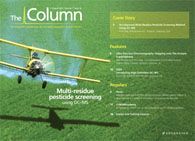Ultra-Fast Gas Chromatography: Stepping onto The Analyte Superhighway
This article discusses some of the technical considerations and practical aspects of UFGC as a method and considers several key applications of its use.
Gas chromatography (GC) is one of several core techniques for chemical analysis and is commonly used in analytical laboratories worldwide. Focusing primarily on separating volatile organic compounds, the applications of GC continue to grow in line with developments in the numerous manufacturing and industrial processes in which it is used.
The principle of GC was first conceived in 1941 by A.J.P Martin who, along with others, suggested the possibility that the liquid phase in liquid/liquid partition chromatography could be replaced by a gas or vapour. In his paper Martin suggests that the increased rates of diffusion of an analyte in gas, when compared with a liquid, would reduce the time taken to reach the equilibrium required for retention and elution. Subsequent to this, Martin et al., produced the first gas chromatogram, which was published in 1951 and described the analysis of a series of fatty acids.
In the 60 years since this pioneering work, there have been significant improvements and developments of the technique, not limited to the GC analysis itself but reaching into the fields of sample handling, column type, stationary phase and method of detection. Modern industrial pressures place a spotlight on increasing sample throughput, reducing costs and consistently and comprehensively satisfying regulatory mandates.
Traditional GC methods are both robust and reproducible. They offer a sensitive analytical approach to the accurate identification and quantification of organic compounds from within complex samples. Established GC methods have separation times that can cause significant delay, with full elution of analytes from a sample often taking 40–60 min. To increase the throughput of samples and the speed of analysis, Fast GC (FGC) and Ultra-Fast GC (UFGC) techniques have been developed.
This article will discuss some of the technical considerations and practical aspects of UFGC as a method and will consider several key applications of its use within various industrial settings.
New Study Reviews Chromatography Methods for Flavonoid Analysis
April 21st 2025Flavonoids are widely used metabolites that carry out various functions in different industries, such as food and cosmetics. Detecting, separating, and quantifying them in fruit species can be a complicated process.
University of Rouen-Normandy Scientists Explore Eco-Friendly Sampling Approach for GC-HRMS
April 17th 2025Root exudates—substances secreted by living plant roots—are challenging to sample, as they are typically extracted using artificial devices and can vary widely in both quantity and composition across plant species.
Sorbonne Researchers Develop Miniaturized GC Detector for VOC Analysis
April 16th 2025A team of scientists from the Paris university developed and optimized MAVERIC, a miniaturized and autonomous gas chromatography (GC) system coupled to a nano-gravimetric detector (NGD) based on a NEMS (nano-electromechanical-system) resonator.

.png&w=3840&q=75)

.png&w=3840&q=75)



.png&w=3840&q=75)



.png&w=3840&q=75)












